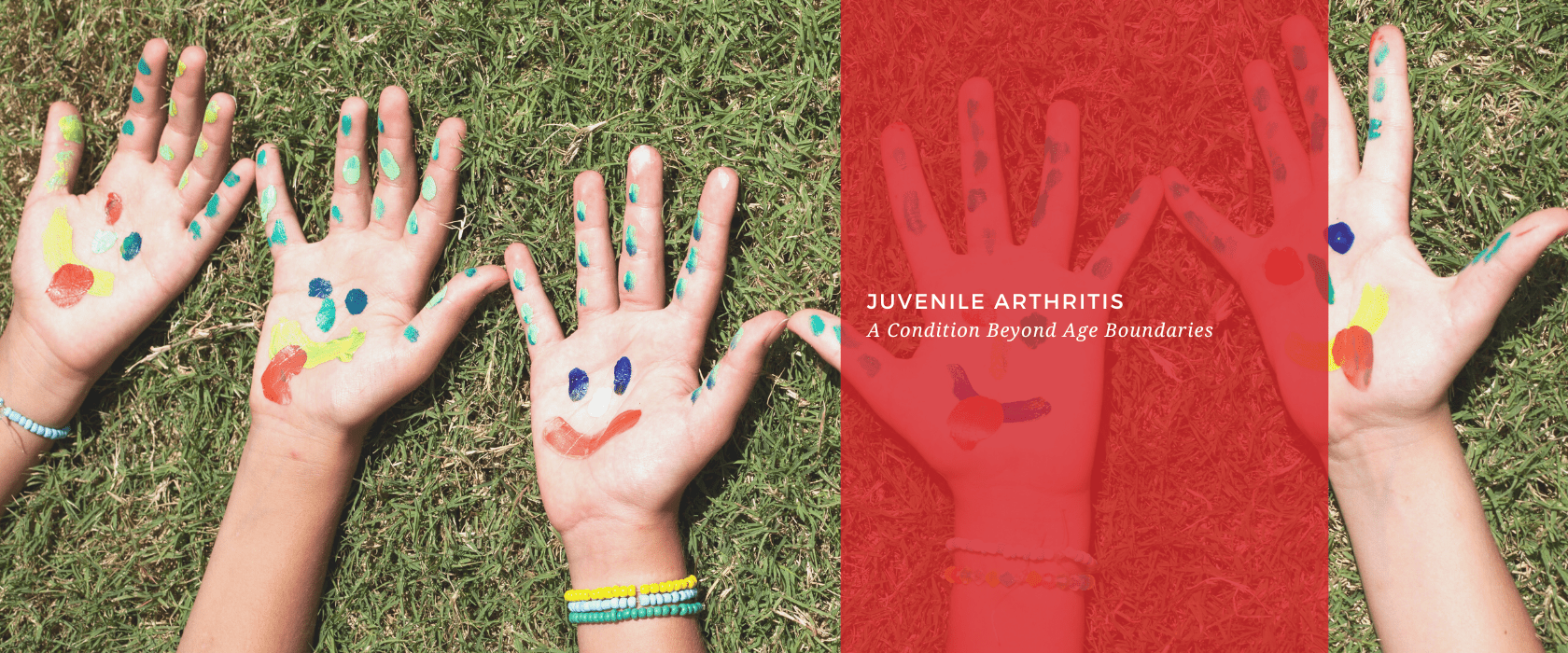With over 1 million orders

Juvenile Arthritis: A Condition Beyond Age Boundaries
For Juvenile Arthritis Awareness Month, we created a post that provides an insightful exploration of juvenile arthritis, emphasizing that it's not merely a childhood disease. It discusses how the condition affects individuals under 16, its potential long-term impacts, and the necessity for ongoing management into adulthood.
Arthritis, a word most of us associate with advancing age, has long been recognized as a burden of later life. However, the disease is not exclusive to the elderly. Arthritis, in fact, strikes indiscriminately across age groups, sparing none. Even the young are drawn into its fold, a fact that often remains under the radar.
Juvenile arthritis is a term unfamiliar to many. But it is a stark reality for more than 300,000 children in the United States alone. The condition requires more public understanding and compassion to dispel misconceptions, understand its various forms, and manage its impact on the lives of young people.

This reality of juvenile arthritis calls us to challenge the common perception of arthritis as an elderly person's disease. It's time to increase awareness of this condition, dispel prevalent misconceptions, and highlight its impact on our younger population.
Juvenile Arthritis Unpacked
Juvenile arthritis isn't a standalone condition. Instead, it's a term that encompasses a group of diseases, all characterized by inflammation of the joints in individuals under the age of 16.
The most prevalent form is Juvenile Idiopathic Arthritis (JIA). 'Idiopathic' signifies that the cause is unknown. Other types include Juvenile Lupus, Kawasaki Disease, and Juvenile Scleroderma, to name a few. These conditions all fall under the juvenile arthritis umbrella, each with its unique set of symptoms and challenges.
The onset of juvenile arthritis can range from subtle to obvious. Some children might complain of a persistent ache in their knee, while others could wake up with a stiff wrist or have visible swelling in their joints. Sometimes, the symptoms might be more generalized, including persistent fevers or rashes. These symptoms often mimic those of more common childhood ailments, which makes juvenile arthritis tricky to diagnose.

Yet, understanding what juvenile arthritis is, is the first crucial step. Despite the diverse ways it can manifest, at its core, juvenile arthritis is an autoimmune disease. This means it occurs when the body's immune system, which normally protects us from foreign invaders like viruses, gets confused and starts attacking healthy cells in the body - in this case, the cells within the joints.
While we don't fully understand why this happens, researchers believe it's a combination of genetic factors and environmental triggers. It's as if the disease is a puzzle, and each child has a unique combination of pieces that, when put together under the right circumstances, leads to the onset of juvenile arthritis.
Spotting the Signs Early
Diagnosing juvenile arthritis can be a complex process, as its symptoms often overlap with those of other more common childhood conditions. It's important to remember that early recognition is key to managing the disease effectively and minimizing its impact on a child's life.
Common signs of juvenile arthritis include joint pain, swelling, and stiffness. A child might limp, especially first thing in the morning or after a nap, or they may have difficulty performing tasks they could previously do with ease, like opening a jar or climbing stairs.

Other signs are less obvious but equally significant. Persistent fever, fatigue, or skin rash could be symptoms of systemic juvenile arthritis, a form of the disease that affects the entire body. Some children might have trouble with their vision or experience unexplained weight loss.
If you notice any of these symptoms in a child, it's crucial to consult a healthcare provider promptly. They can perform a variety of tests, including blood tests, x-rays, and physical examinations, to arrive at a diagnosis.
While the path to diagnosing juvenile arthritis can be intricate and potentially stressful, understanding the signs and seeking timely medical help is an important step toward helping a child manage the condition and maintain a high quality of life.
Managing the Condition
Once a diagnosis of juvenile arthritis is confirmed, the next step is formulating an effective treatment plan. While there's currently no cure for the condition, treatment can significantly alleviate symptoms, prevent joint damage, and help the child lead a normal, active life.
The treatment for juvenile arthritis is multidisciplinary and personalized to each child. It can involve a team of healthcare professionals, including pediatric rheumatologists, physical therapists, and possibly even psychologists.
Medication is often the first line of treatment. Non-steroidal anti-inflammatory drugs (NSAIDs) can help manage pain and inflammation. If symptoms persist, doctors might prescribe disease-modifying anti-rheumatic drugs (DMARDs) or biologic agents, which aim to slow down the progression of the disease by modifying the immune system.
In addition to medication, physical therapy plays a crucial role in maintaining joint flexibility and muscle strength. Therapists might recommend exercises that can be performed at home or assistive devices to help the child perform daily activities with minimal discomfort.
Lastly, healthy lifestyle choices such as maintaining a balanced diet and getting regular exercise can help manage symptoms and improve overall well-being.
Remember, each child's experience with juvenile arthritis is unique, and what works for one might not work for another. The goal is to find a treatment strategy that ensures the child can lead a fulfilling life, unhindered by their condition. Regular follow-ups and open communication with the healthcare team are vital in achieving this goal.
Navigating Life with Juvenile Arthritis

Managing juvenile arthritis isn't solely about medications and physical therapy—it also involves fostering a supportive environment for the child. This helps them cope with the physical and emotional challenges of the disease.
Parents, caregivers, and teachers play a significant role in this aspect. They should be educated about the disease, its implications, and ways to provide assistance when necessary. Creating an understanding environment at home and school can help the child feel less isolated and more confident about managing their condition.
Encourage open dialogue about the child's feelings and experiences. They may be dealing with feelings of frustration, fear, or confusion that can be difficult to express. Mental health professionals can provide valuable support in these situations, helping children develop coping mechanisms and resilience.
Support groups, both online and offline, can also be a great resource. Interacting with others who are facing similar challenges can provide a sense of community and shared understanding. These platforms often provide practical tips, emotional support, and an opportunity to learn from others' experiences.
Supporting a child with juvenile arthritis goes beyond addressing their physical symptoms—it's about nurturing their emotional well-being and ensuring they're not defined by their condition. With a comprehensive support system, children with juvenile arthritis can live fulfilling lives, undeterred by their diagnosis.
Growing Up with Juvenile Arthritis
Living with juvenile arthritis doesn't end with childhood. It's a journey that continues as the child grows into an adolescent and eventually, an adult. The disease and its management evolve during these different life stages, requiring adaptation and reassessment.
Through the years, they might experience changes in their disease activity. Some may see an improvement in their symptoms or even complete remission. For others, the disease might persist or even become more active. Regular medical follow-ups can monitor these changes and adjust treatment plans accordingly.
The transition from pediatric to adult rheumatology care is another critical phase. This shift involves more than just changing doctors—it's about the adolescent taking on increased responsibility for their health. They'll need to learn about managing their medications, recognizing disease flares, and coordinating their healthcare needs.
Moreover, as they enter adulthood, individuals with a history of juvenile arthritis may face new challenges, such as career choices and starting a family. These decisions might need to take into account their disease and its management. For instance, certain medications might need to be stopped or switched before planning for pregnancy.
Mental health support remains crucial during this period. Adolescents and young adults might struggle with the emotional impact of growing up with a chronic disease. Counseling or therapy can help them navigate these feelings and develop a healthy coping mechanism.
Growing up with juvenile arthritis presents its unique challenges. However, with a supportive environment, comprehensive medical care, and mental health support, individuals can lead successful lives while managing their condition effectively. It's important to remember that while juvenile arthritis might be a part of their life, it doesn't define who they are or what they can achieve.
Looking Ahead: The Path Forward with Juvenile Arthritis
The journey with juvenile arthritis may seem daunting, but it's crucial to remember that it's a manageable condition. With the right tools and support, children with juvenile arthritis can live fulfilling, active lives and reach their full potential.
What's even more encouraging is that we're living in an era of significant advancements in medical science. Our understanding of juvenile arthritis is constantly evolving, and with it, our approach to treatment. Novel therapies are being developed that aim to target the disease more effectively and with fewer side effects. Each day brings us a step closer to a future where living with juvenile arthritis could be less about managing symptoms and more about long-term remission or even a cure.
Supporting a child with juvenile arthritis may have its challenges, but there are also opportunities - to foster resilience, practice empathy, and celebrate victories, big and small. The path may be steep at times, but with every stride forward, we move closer to a world that understands juvenile arthritis better, supports those living with it more effectively, and eventually finds a way to conquer it entirely. For those navigating life with juvenile arthritis today, remember - you're stronger than you think, and you're not walking this path alone.
Read more about Juvenile Arthritis:
Juvenile Arthritis Diagnosis: Early Detection and Diagnosis
Juvenile Arthritis Treatment: An Exploration of Available Options
